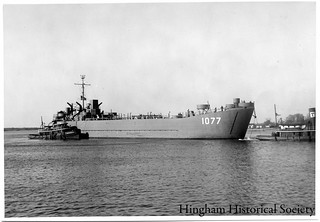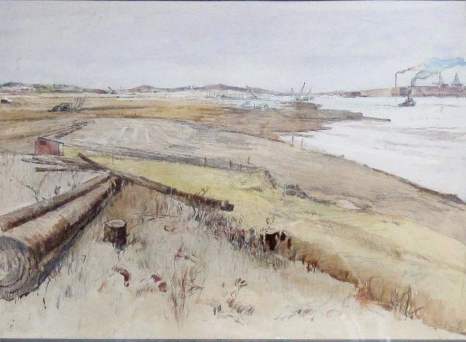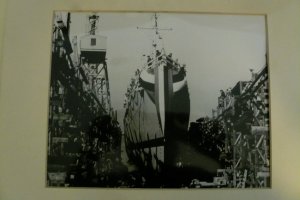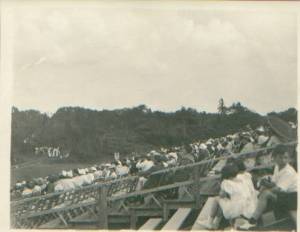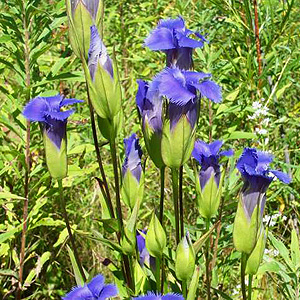Meg Ferris Kenagy, author and chronicler in this space of her family’s history in Hingham and beyond, recently donated three Christmas cards sent home to Hingham by her father and two of her uncles during their service in the U.S. military during World War II. Each young man was stationed in the Pacific Theater–far from home–and each remained away for several years, with his only contact with loved ones coming via cards and letters. These three holiday cards, therefore, are more than novelty items that look so different from cards we are sending each other right now. Rather, they are also a tangible reminder during the holiday season of how fortunate most of us are to be able to celebrate with those nearest to us.
 Hingham native Oliver L. (“Morg”) Ferris (1918-1985) served in the Army Air Corps as an airplane mechanic stationed in Hawaii and Guam, achieving the rank of Sergeant. He was a married man when he entered the service; while he was abroad, his wife, Margaret (“Rita”) Ferris, lived with her parents, the Scanlans, in Dorchester. For Christmas 1944, Morg sent Rita and her parents an Army Air Corps Christmas card which he signed on the front: “With all my love, Morg.” The card, postmarked December 9, 1944, shows aircraft in formation flying out of clouds towards what looks like a Christmas star. Between border decorations of palm trees and holiday wreaths at the top and bottom, it includes an inspirational, mission-driven message: “That It Might Shine On.”
Hingham native Oliver L. (“Morg”) Ferris (1918-1985) served in the Army Air Corps as an airplane mechanic stationed in Hawaii and Guam, achieving the rank of Sergeant. He was a married man when he entered the service; while he was abroad, his wife, Margaret (“Rita”) Ferris, lived with her parents, the Scanlans, in Dorchester. For Christmas 1944, Morg sent Rita and her parents an Army Air Corps Christmas card which he signed on the front: “With all my love, Morg.” The card, postmarked December 9, 1944, shows aircraft in formation flying out of clouds towards what looks like a Christmas star. Between border decorations of palm trees and holiday wreaths at the top and bottom, it includes an inspirational, mission-driven message: “That It Might Shine On.”
Morg’s younger brother Richard Ferris (1921-2016) was also serving in the Pacific with the Army Air Corps, but his choice of Christmas card could not have been more different! Richard served in the National Guard from 1939 to 1940 and, from 1941 to 1945, with the Army Air Corps as a member of the 3rd Bomber Group, which took the nickname “The Grim Reapers.”
Air Corps, but his choice of Christmas card could not have been more different! Richard served in the National Guard from 1939 to 1940 and, from 1941 to 1945, with the Army Air Corps as a member of the 3rd Bomber Group, which took the nickname “The Grim Reapers.”
Richard’s card features the outline of the island of New Guinea drawn with an overlay of a burning ship and attacking airplanes. The emblem of the “Grim Reapers”–a skeleton carrying a bloody scythe–is printed in the upper right, while “Season’s Greetings” is printed in red and blue at the bottom left. The printed message on the inside is perhaps a bit jarring for a greeting card:
This is our busy season / We hope you’ll excuse us, please
The Grim Reapers have to harvest / Those sons of the Nipponese.
We can only pause a moment / To wish you Christmas Cheer;
But this we guarantee you: / Peace during the Coming Year.
The card is signed in pencil, “Richard.”
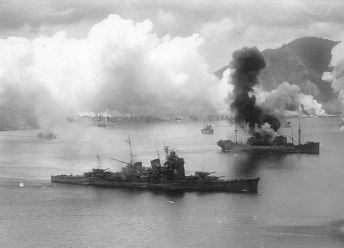 While the card is undated and bears no postmark, the context suggests it may have been sent for Christmas 1943, when the Third Bomber Group was indeed very “busy” with aerial bombing of New Guinea, as the allies fought a lengthy campaign to win New Guinea, which had been invaded by the Japanese in 1942. (Shown here: the 3rd Bomber Group attacks Japanese ships in Simpson Harbor, New Guinea, Nov. 2, 1943. Photo courtesy of the
While the card is undated and bears no postmark, the context suggests it may have been sent for Christmas 1943, when the Third Bomber Group was indeed very “busy” with aerial bombing of New Guinea, as the allies fought a lengthy campaign to win New Guinea, which had been invaded by the Japanese in 1942. (Shown here: the 3rd Bomber Group attacks Japanese ships in Simpson Harbor, New Guinea, Nov. 2, 1943. Photo courtesy of the
Dorchester native Edward Scanlan (1920-1965) was Rita Ferris’ brother. and Morg and Richard’s brother-in-law. He served in the Navy as a marine engineer and was stationed in the Philippines. His  undated card, sent to Morg and Rita, riffs on exotic travel posters of the day, featuring a four-color picture of a G.I. drinking from a coconut shell or wooden bowl offered by a native woman, while a native man operates a well nearby. “All’s Well in the Philippines,” the card reassures the recipient (albeit with a very bad pun). Inside, Ed has carefully handwritten the names of various cities in the Philippines in a style suggestive of steamer trunk labels and wrote:
undated card, sent to Morg and Rita, riffs on exotic travel posters of the day, featuring a four-color picture of a G.I. drinking from a coconut shell or wooden bowl offered by a native woman, while a native man operates a well nearby. “All’s Well in the Philippines,” the card reassures the recipient (albeit with a very bad pun). Inside, Ed has carefully handwritten the names of various cities in the Philippines in a style suggestive of steamer trunk labels and wrote:
Greetings Rita and Morg, We may leave the P.I.’s today or tomorrow for Finchauen, New Guinea; we aren’t sure yet. That is, I haven’t decided. I’d like to send Morg’s family a card but I don’t know the address so please give them my regards. See you in the funny papers. Keep smiling, Big Brother Ed.
On the back of the card, Ed added a wistful postscript: You’re on the right side of the ocean; when you’re in the good old U.S.A.
- Oliver L. “Morg” Ferris. Honolulu, Feb. 1944
- Richard Ferris. Undated Hingham Fire Dep’t portrait
- Ed Scanlan, U.S. Navy, Feb. 1943
Happily, all three young men returned home.
Morg returned home to Rita, and they had seven daughters, including Meg Kenagy, the donor of these cards. Richard married Muriel Richards and served in the Hingham Fire Department from 1947 to 1967, achieving the rank of Lieutenant. When Ed returned, he married Pauline Russell and also became a firefighter, for the Boston Fire Department.





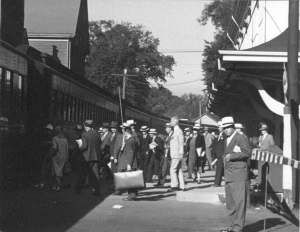 American, regardless of ethnicity, and Eleanor was thrilled to discover that the Hingham High School football squad that year had players whose families had come from eight different parts of the world and that Hingham was home to Dutch and Polish farmers, Italian shoe makers, and a German harness maker, amongst many others. In 1942 Hingham had a population of 8,000. It still had 50 farms—but it also had a commuter train., and much of its population now travelled to work in Boston. There were, of course, schools, churches of all kinds, and a public library with 28,000 volumes. The Loring Hall movie theater would be showing Citizen Kane the following week.
American, regardless of ethnicity, and Eleanor was thrilled to discover that the Hingham High School football squad that year had players whose families had come from eight different parts of the world and that Hingham was home to Dutch and Polish farmers, Italian shoe makers, and a German harness maker, amongst many others. In 1942 Hingham had a population of 8,000. It still had 50 farms—but it also had a commuter train., and much of its population now travelled to work in Boston. There were, of course, schools, churches of all kinds, and a public library with 28,000 volumes. The Loring Hall movie theater would be showing Citizen Kane the following week.
